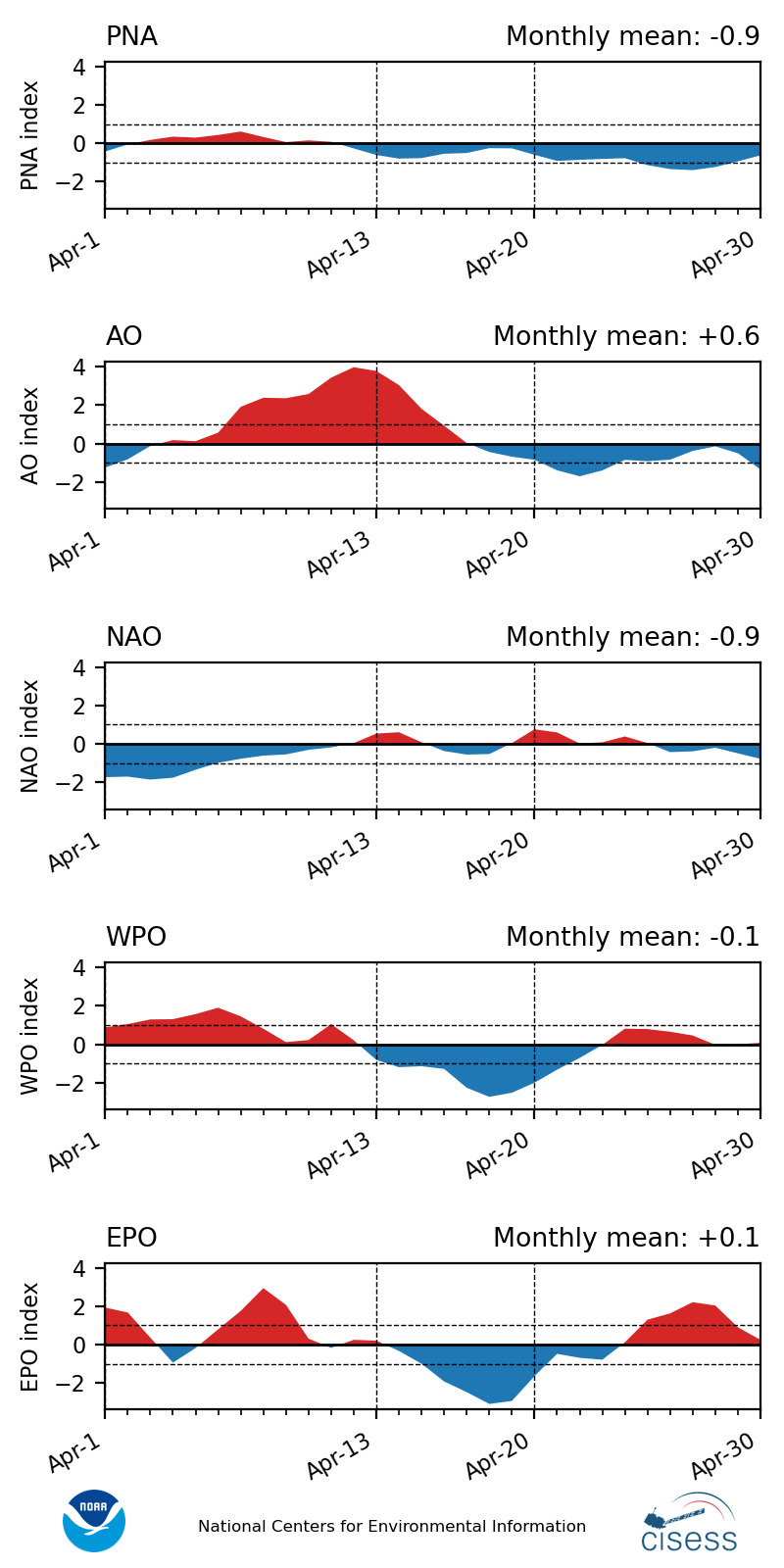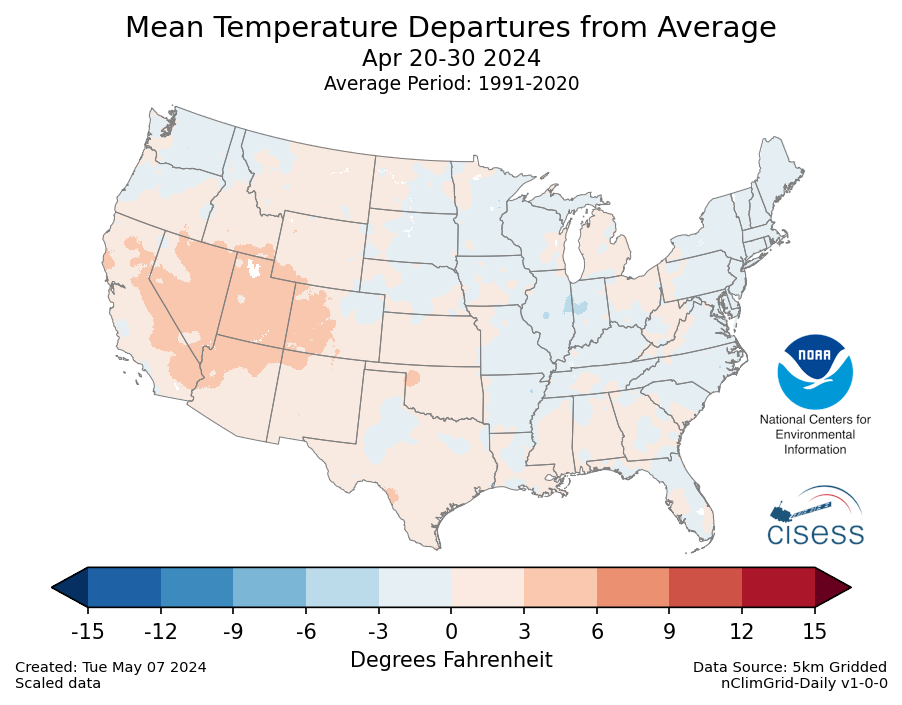Note: This Synoptic Discussion describes recent weather events and climate anomalies in relation to the phenomena that cause the weather. These phenomena include the jet stream, fronts and low pressure systems that bring precipitation, high pressure systems that bring dry weather, and the mechanisms which control these features — such as El Niño, La Niña, and other oceanic and atmospheric drivers (PNA, NAO, AO, and others). The report may contain more technical language than other components of the State of the Climate series.
Overview
Key Drivers
- Month
- El Niño
- Oscillating Arctic Oscillation (AO)
- Oscillating West Pacific Oscillation (WPO)
- Oscillating East Pacific Oscillation (EPO)
-
April 1-12
- Positive AO
- Negative North Atlantic Oscillation (NAO)
- Positive WPO
- Positive EPO
-
April 13-19
- Negative Pacific/North American (PNA) pattern
-
April 20-30
- Negative PNA
- Negative AO
- Positive EPO
Summary
The North American circulation at the beginning of the month was characterized by very dynamic conditions across the U.S. with a train of ridges and troughs moving across the country. During the middle portion of the month, the wave pattern was interrupted by persistent ridging across most of the country. This led to generally warmer and drier conditions during the middle of April across the U.S., particularly over the eastern half of the country and the Midwest. A more dynamic pattern emerged during the end of the month again, leading to more moderate temperatures over most of the U.S. Overall, the month of April saw warmer than normal conditions across most of the country, with the largest departures from average occurring over and near the Ohio Valley. During the month of April enhanced precipitation occurred over the Midwest, with drier conditions over the Rockies.
Submonthly Evolution
April 1-12
During the first two weeks of April, there was a dynamic synoptic pattern with a wave train of ridges and troughs moving across the country. There was also enhanced precipitation over the eastern and southern U.S. during the early part of the month which was associated with El Nino and maybe the negative NAO. During this period the WPO and EPO were both positive, and both are typically associated with warmer than normal conditions in the eastern U.S. during April, which was observed. There was also a positive AO during the early part of the month, which correlates with the warmer temperatures observed over the eastern half of the U.S. during this period.
April 13-19
During the middle part of April, the synoptic pattern was characterized by strong ridging over most of the country. This ridging was possibly a result of the negative PNA or the positive AO early in the period. Correspondingly there were warmer than normal conditions experienced over much of the U.S., particularly over the Great Plains and Midwest. The WPO and EPO were both strongly negative during the middle of April, but the persistent ridging overcame the typically cooler temperature patterns associated with the WPO and EPO. Dry conditions were experienced over much of the southern U.S. with some precipitation occurring over the northern U.S. in the upper Great Plains as well as in California.
April 20-30
During the end of April, the overall synoptic pattern was similar to the early part of the month. A very dynamic ridge and trough pattern emerged, resulting in temperatures that were near average across most of the country. Temperatures were slightly warmer than average over the Southwest. The end of April saw wetter than normal conditions across the Great Plains and southern Rockies. The negative AO during the end of the month may have contributed to the enhanced precipitation over Texas, Louisiana, and Arkansas and drier-than-normal conditions over the eastern CONUS.
Atmospheric Drivers
ENSO: El Niño Southern Oscillation
- Description: Oceanic and atmospheric conditions in the tropical Pacific Ocean can influence weather across the globe. ENSO is characterized by two extreme modes: El Niño (warmer-than-normal sea surface temperature [SST] anomalies in the tropical Pacific) and La Niña (cooler-than-normal SST anomalies), with the absence of either of these modes termed “ENSO-neutral” conditions. These variations in SST change the locations of the Pacific's largest thunderstorms, which can in turn change circulation patterns around the globe.
- Status: El Niño conditions continued during April. The most common metric for ENSO is the SST anomalies in the equatorial Pacific. The SST anomalies in the Niño3.4 region decreased to around 0.8°C during April. The Southern Oscillation Index, which measures the atmospheric response, was around -0.2. Together, the coupled ocean-atmosphere system was consistent with a weakening El Niño.
- Teleconnections (influence on weather): El Niño favors cooler temperatures for most of the contiguous U.S. Cooler than normal conditions were seen during the end of April over the eastern U.S. when the ridging was less pronounced. El Niño is also associated with wetter conditions for the Great Plains and southern U.S. along with drier conditions for the northern U.S. Wetter than normal conditions were seen across the southeast and western U.S., matching the typical pattern.
MJO: Madden-Julian Oscillation
- Description: The MJO is the biggest source of subseasonal (20-60 day) tropical variability. It typically develops as a large envelope of tropical thunderstorms over the Indian Ocean that then moves eastward. Like ENSO, the MJO's effects on tropical rainfall is so strong that it can alter the atmospheric circulation around the globe. The thunderstorms decay when they cross the Pacific, but the associated winds can often continue across the Western Hemisphere to initiate the next MJO in the Indian Ocean. The MJO is episodic, meaning that it is not always active. The MJO index identifies both the MJO's amplitude and the longitude of its strongest rainfall. MJO amplitude is represented by the distance from the center of the figure with values outside the circle are considered active. The eight phases around the circle indicate the MJO's location.
- Status: The MJO index was weak during most of April, but did progress from Phase 2 through 4 during the latter part of the month.
- Teleconnections (influence on weather): During April, the weak MJO meant that teleconnections were weak throughout most of the month. During the end of the month MJO Phase 3 was observed, which corresponds to cooler than normal conditions over the upper Midwest. Phase 4 corresponds to drier than normal conditions over the Southwest and southern Plains. This pattern was partially observed during the end of April.
PNA: Pacific/North American Pattern
- Description: The PNA teleconnection pattern is associated with strong fluctuations in the strength and location of the East Asian jet stream. PNA-related blocking of the jet stream flow in the Pacific can affect weather downstream over North America, especially the West and especially in the winter half of the year.
- Status: The daily PNA index was weakly positive during the beginning of April, and transitioned to weakly negative afterwards. The monthly mean was -0.9.
- Teleconnections (influence on weather): The positive PNA generally favors warmer than normal conditions for the Pacific Northwest and cooler for the Southeast. These patterns were generally not observed during April. The positive PNA also favors wetter than normal conditions for the southern Rockies and eastern U.S. These conditions were also generally not observed during the month.
AO: Arctic Oscillation
- Description: The AO teleconnection pattern generally measures the pressure difference between the low pressure over the North Pole and the higher pressures in the subtropical ridges. This pressure difference is larger during a positive AO, resulting in a stronger midlatitude jet. When the AO is negative, the jet is weaker and will have larger troughs and ridges.
- Status: The daily AO index began the month strongly positive, and transitioned to negative for the second half of the month. The monthly mean was +0.6.
- Teleconnections (influence on weather): The positive AO is typically associated with warmer than normal conditions across the central U.S., which were observed during the early to middle part of the month of April. During the end of the month negative AO conditions were observed, which is associated with cooler than normal conditions. The negative AO is associated with cooler than normal conditions across the country which could help explain the cooler conditions observed during the end of the month. The negative AO observed during the end of the month corresponded to the wetter conditions that occurred over Texas, Louisiana, and Arkansas.
NAO: North Atlantic Oscillation
- Description: The NAO teleconnection pattern relates the pressure over the sub-polar low near Greenland and Iceland with the subtropical high over the Central Atlantic. It significantly affects the weather on both sides of the Atlantic.
- Status: The daily NAO index was negative during the beginning of April, but was near neutral for the remainder of the month. The monthly mean was -0.9.
- Teleconnections (influence on weather): The NAO is positively correlated with temperatures over most of the U.S. during April. The corresponding patterns were generally not observed during April. A negative NAO is correlated with above-normal precipitation in the Southeast, which occurred early in the month.
WPO: West Pacific Oscillation
- Description: The WPO teleconnection pattern is a primary mode of low-frequency variability over the North Pacific and reflects zonal and meridional variations in the location and intensity of the East Asian jet stream in the western Pacific.
- Status: The daily WPO index was positive during the beginning of April, negative during the middle of the month, and weakly positive during the end of the month. The monthly mean was -0.1.
- Teleconnections (influence on weather): The positive WPO is typically associated with warmer temperatures over the northern and central U.S., and with cooler conditions over the southwestern U.S. The cooler conditions over the Southwest were observed during the beginning of April. Ridging countered the typical pattern of the negative WPO during the middle of the month. The WPO does not have a strong influence on precipitation patterns during the month of April.
EPO: East Pacific Oscillation
- Description: The EPO pattern identifies variations in the strength and location of the eastern Pacific jet stream. During the positive phase, the jet is stronger and shifted southward. The negative phase is associated with an Alaskan ridge that weakens the jet. The EPO is closely related to the East Pacific–North Pacific (EP–NP) teleconnection pattern, although the two are defined with opposite signs.
- Status: The daily EPO index was mostly positive during the first third of the month, strongly negative during the middle third, and positive once again during the final third of April. The monthly mean was +0.1.
- Teleconnections (influence on weather): The positive phase of the EPO favors warmer than normal temperatures across the northern and eastern U.S. The observed patterns matched the positive EPO patterns across the northern and eastern U.S. during the beginning of the month. During the middle of the month, strong ridging largely countered the effects of the negative EPO that was observed.
 NOAA's National Centers for Environmental Information
NOAA's National Centers for Environmental Information

























